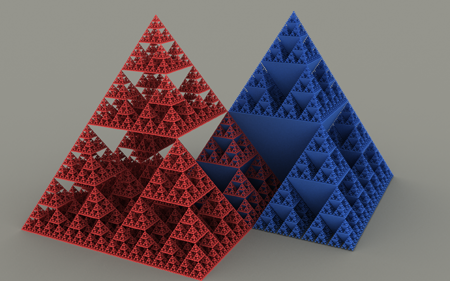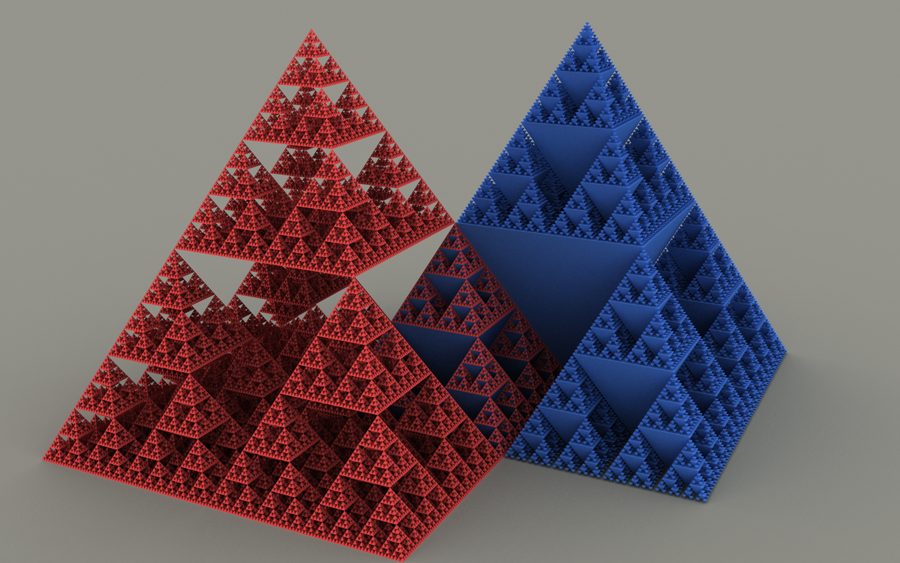Glimmers of a connection between string theory and atomic physics
String theory is well known as a possible route to unification of gravity and quantum mechanics. But its historical roots lie in another direction: strings were originally proposed as a way to describe the strong force that governs quarks—called quantum chromodynamics (QCD)—when the particles are at low energies (intuitively, the strings are the tubes of glue that connect and confine the two quarks in a meson).
One of the most interesting features of this theory is that the strong force only becomes strong at low energies. It is hard to carry out computations in this strongly coupled theory, since perturbation theory in the coupling doesn’t work. It would be useful therefore if one could guess a correct new set of variables with which to describe the theory, which would interact weakly and make the most relevant physics evident. A familiar example of such a “dual” theory is the Landau-Ginzburg description of superconductors, where a simple description in terms of a scalar order parameter captures the complicated physics of the underlying fundamental electron bound-state Cooper pairs. It has long seemed likely that QCD should have an “effective” (that is, weakly coupled) description in terms of a theory where the fundamental objects are strings (which bind quarks into mesons) instead of point particles.
Effective string descriptions have also been considered for spin systems like the Ising model in three dimensions, where two-dimensional surfaces separate the domains of “up” and “down” spin and hence computations involving two-dimensional worldsheets (analogous to the worldlines of a single particle—in other words a string rather than point particle picture) seem natural. In recent years, these two sets of considerations, involving “fundamental” vs “effective” strings, have dovetailed nicely: it has turned out that certain special solutions of fundamental string theory provide effective string descriptions of normal field theories, similar in many ways to QCD.
The papers by D. T. Son in Physical Review D [1] and by K. Balasubramanian and J. McGreevy in Physical Review Letters [2] propose an intriguing new extension of the relation between fundamental and effective strings. They find that under certain special circumstances, the strings commonly studied by string theorists can provide a description of nonrelativistic field theories similar to those that govern gases of cold atoms in atomic traps. This work, along with a growing body of other papers, is another step in a promising recent trend of finding special string solutions that capture the dynamics of strongly coupled field theories whose behavior is similar (in some respects) to field theories realized in laboratory condensed-matter or atomic systems. In coming years, we can expect further papers trying to sharpen these results, with the goal of finding effective string descriptions that quantitatively (as opposed to qualitatively) describe atomic or condensed-matter systems. But as with QCD, where we currently have string solutions describing QCD-like theories but not QCD itself, we can hope to learn fascinating qualitative lessons even without a precise quantitative match between the string theory and the atomic system.
It helps to recall how our current string descriptions of QCD-like theories were discovered. In the 1970s, field theorists interested in the study of strong interactions quickly realized that quantum chromodynamics is too difficult to solve but, ironically, ‘t Hooft showed that analogues of this theory with a very large number ( ) of gluons could be analytically tractable [3]. There were also impressive hints that the three-dimensional Ising model might be recast as a string theory [4], however this was, and still remains, difficult to make precise.
Progress in finding a string theory of QCD occurred in the late 1990s, after Polchinski’s discovery of the importance of a special class of objects called branes [5], classical solutions of the field equations of ten-dimensional fundamental string theory. A brane is a slice of space (imagine a sheet of paper extending to infinity) on which closed loops of string can break open and end. For each p-dimensional brane, there is a p+1-dimensional quantum theory describing the possible excitations (e.g., the collective coordinates that allow the plane to move around in the larger space). On parallel branes, one in fact obtains a relative of the gluon QCD theory proposed by ‘t Hooft.
Maldacena (building on the work of Klebanov and Polyakov) realized that there is another useful description of this theory [6], namely a gravitational solution that is weakly curved in the limit of a large number of branes. There is by now very convincing evidence for the correctness of this conjecture. In further work, theories that exhibit some of the hallmark properties of QCD, like confinement of quarks, have been given precise string descriptions [7]; but no useful description of QCD itself has yet emerged.
This set of discoveries has come to be known as the “AdS/CFT” correspondence. The gravitational solution of string theory that applies here looks like anti-de Sitter spacetime (AdS), that is, a solution of Einstein’s field equation in which there is no matter present, but the cosmological constant is attractive (i.e., negative vacuum energy). A Lorentz-invariant theory that has scale invariance typically enjoys a larger group of symmetries, called the conformal group. The “CFT” refers to the name for such theories, “Conformal Field Theories.” The equivalence between the two objects implies that AdS space should have the symmetries of the conformal group. These symmetries appear as generalized rotations and translations of the AdS geometry.
How is the conformal group related to sets of symmetries that most physicists play with? We are familiar with Einstein’s realization that in a world where the speed of light is a universal constant in each reference frame (i.e., frames moving with different velocity relative to one another), the mechanics of Newton must undergo a dramatic modification. The symmetry group in Einstein’s theory is something called the “Lorentz group.” It includes the transformations that allow one to switch from one reference frame to another, in a world (like ours) where the speed of light is a universal constant.
One can further assume that there are symmetries under dilation or scale transformations of spacetime. That is, one can take and , while leaving the action of the theory invariant. Here, rescales the physical coordinates, so such transformations are called scale transformations. A theory with this symmetry, in addition to Lorentz symmetry, can be shown (almost always) to have a much larger group of symmetries: the conformal group.
In any attempt to describe QCD, conformal invariance is a nuisance: QCD has strong coupling and confinement at large distances, while the short-range theory is one of free quarks and gluons. But in many atomic and condensed-matter systems, the opposite is true. By tuning the strengths of interactions in a laboratory to a critical value, experimentalists can arrange to sit at a point of transition between two different phases of behavior. These points of transition are special, and often exhibit scale invariance (Fig. 1). The understanding of the role of scale-invariant theories in the theory of phase transitions of materials is one of the triumphs of quantum field theory, attributed to Wilson and many others.
There is a catch: in experiments there is a preferred frame—the laboratory frame. The atoms or other constituents of the experiment are interacting on time scales that are very long compared to the travel time of light over the scale of the experiment: the speed of light is irrelevant (it can be considered infinite). The symmetry group in some of these systems is effectively the Galilean group (where physics in frames differing by a constant shift of velocity must be invariant), instead of the Lorentz group.
What happens in a theory that has both Galilean invariance and scale invariance? In the Galilean group, time plays a different role from space. The proper notion of scale invariance requires that under a dilation , then we must have . (This is familiar from nonrelativistic quantum mechanics: in the Schrödinger equation for a free particle, if one rescales to , one must rescale to to get a symmetry of the equation because it is first order in time derivatives but second order in spatial derivatives.) The full group of symmetries of such theories is enhanced, beyond just such dilations and Galilean transformations, to a group known as the Schrödinger group. This is the analogue, for Galilean invariant systems, of the conformal group. Recently, various experimental groups have succeeded in tuning interacting atomic systems close to a Schrödinger invariant phase transition [8]. These experiments involve extremely cold trapped atoms; by tuning a magnetic field that controls hyperfine splittings of atomic levels, one can find a transition between conventional BCS and BEC phases of atoms that is well described by a Schrödinger invariant theory. The theory at the transition point is believed to be strongly coupled and inaccessible to analytical calculations. In this sense, it is similar to QCD at low energies.
Is there an effective description of the theory governing these phase transitions, using different degrees of freedom? The recent work of Son, Balasubramanian, and McGreevy, suggests that the answer is “yes.” They have found solutions of higher-dimensional gravity theories (which could very plausibly emerge from string theory) that have the correct symmetries, the Schrödinger symmetries, to be dual to Galilean-invariant field theories (nonrelativistic field theories) with the anisotropic scale invariance , . Of course, as with the case of QCD, one expects that their solutions are describing theories that are only qualitatively similar to the atomic systems of interest.
Since this work, in fact, the solutions of these groups have been successfully embedded into string theory in three recent papers [9]. The known string solutions are dual to Schrödinger-invariant theories with some notable differences from the atomic system. But just as with the duality between string theory and QCD, we can expect that further research will reveal mechanisms to remove some of the unwanted features of the known string solutions, approaching the behavior of the cold atomic phase transition ever more closely. It remains unclear whether one can find a dual of an experimentally realizable atomic system, but the hunt is on.
References
- D. T. Son, Phys. Rev. D 78, 046003 (2008)
- K. Balasubramanian and J. McGreevy, Phys. Rev. Lett. 101, 061601 (2008)
- G. 't Hooft, Nucl. Phys. B 72, 461
- A. Polyakov, Gauge fields and strings[Amazon][WorldCat], Harwood press, 1987; E. Fradkin, M. Srednicki, and L. Susskind, Phys. Rev. D 21, 2885 (1980)
- J. Polchinski, Phys. Rev. Lett. 75, 4724 (1995)
- J. Maldacena, Adv. Th. Math. Phys. 2, 231 (1998)
- J. Polchinski and M. Strassler, arXiv:hep-th/0003136; I. R. Klebanov and M. J. Strassler, J. High Energy Phys. 08 (2000) 052
- J. Kinast, S. L. Hemmer, M. E. Gehm, A. Turlapov, and J. E. Thomas, Phys. Rev. Lett. 92, 150402 (2004); J. Kinast, A. Turlapov, and J. E. Thomas, 94, 170404 (2005)
- C. Herzog, M. Rangamani, and S. F. Ross, arXiv:0807.1099; J. Maldacena, D. Martelli, and Y. Tachikawa, arXiv:0807.1100; A. Adams, K. Balasubramanian, and J. McGreevy, arXiv:0807.1111





